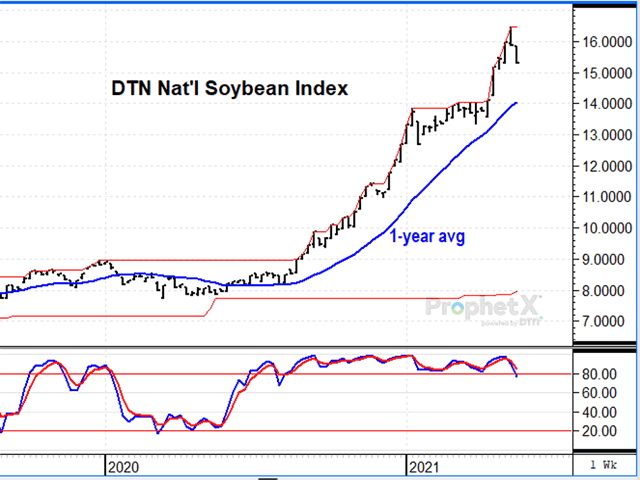Todd's Take
Bearish Riddles in Soybean Futures
It was roughly nine months ago, on Aug. 24, 2020, when I first wrote in this space about a cluster of bullish clues coming together for corn and soybeans (see https://www.dtnpf.com/…).
DTN's National Soybean Index was at $8.55 per bushel at the time and we couldn't yet see just how bullish things would become. But China's early appetite for corn and soybean imports, new highs in Brazil's prices shortly after successful harvests of both and higher-than-normal domestic prices of corn and soybeans in China all pointed like neon signs to the higher corn and soybean prices that followed.
Now, in May 2021, DTN's National Soybean Index hit a high of $16.47 on May 12, the same day USDA estimated U.S. old-crop ending soybean stocks at 120 million bushels (mb) for the fourth consecutive month. Since then, prices have fallen, closing at $15.23 on Thursday, May 20.
A drop of $1.24 per bushel at this high price level is well within the range of volatility we would normally expect this time of year and is not a bearish concern by itself. What is troubling is how quickly DTN's cash index is losing ground to the futures board.
The national cash basis has fallen from 7 cents above the July contract on April 30 -- the strongest basis in eight years -- to 10 cents below the July contract on May 20, a drop of 17 cents in less than a month. Clearly, the surge of commercial demand we witnessed for cash soybeans across the Midwest in April and early May has cooled and we haven't seen it stabilize yet.
P[L1] D[0x0] M[300x250] OOP[F] ADUNIT[] T[]
If this were the only bearish concern, we could brush it aside, but there's more. The day after the World Agricultural Supply and Demand Estimates (WASDE) report, July soybean meal plummeted $27.40, the largest drop that particular contract has seen in one day. Prices have fallen another $20.30 since then, closing at a new one-month low of $401.10 Thursday. Even Monday's lower-than-expected soybean crush total of 160.3 mb from the National Oilseeds Processors Association wasn't enough to stop a six-day slide in meal prices.
The confusing part of this is the July meal contract shows a small premium of $1.30 above the August contract, so there is some evidence of demand. Even as soybean basis has relaxed, there is no question U.S. soybean supplies are tight. Perhaps the best explanation of the moment is that the combination of lower U.S. hog inventory in 2021 and an aggressive crush pace earlier in the year, has soybean meal supplies in a comfortable position for the time being.
We should also note there has been talk of soybean shipments to the U.S. from Brazil. The rumored amounts have been relatively small so far, roughly 7 mb or so, but there is potential for more this summer. That leads us to what I suspect is the most bearish influence on soybean prices this month, a delayed reaction of competition from Brazil.
Brazil's record harvest of nearly 5.0 billion bushels (bb) has been widely anticipated for months. When U.S. soybean prices charged higher in April and early May, it seemed like a bullish slap in the face, as if even Brazil's competition couldn't hold down prices. Since the May 12 price peak, however, and 17-cent drop in cash basis, Brazil's $1.33 per bushel discount in the FOB price for June compared to the FOB price at the U.S. Gulf appears to now be exerting a larger bearish influence.
The bearish clues described above don't make me believe a large drop in U.S. soybean prices is coming anytime soon, as it is still not certain if the U.S. will be able to produce enough soybeans in 2021 to meet demand. It is worth remembering, however, that this time on the calendar favors Brazil and will likely stay that way the next few months.
The major source of soybean demand continues to flow from China, and on that point, there is no sign of slowing yet.
**
Comments above are for educational purposes only and are not meant as specific trade recommendations. The buying and selling of grain or grain futures or options involve substantial risk and are not suitable for everyone.
Todd Hultman can be reached at Todd.Hultman@dtn.com
Follow him on Twitter @ToddHultman1
(c) Copyright 2021 DTN, LLC. All rights reserved.






